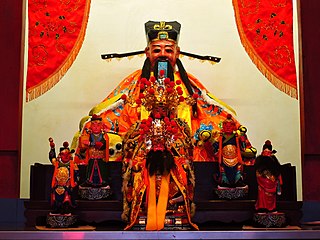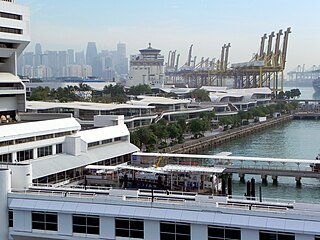
The Chenghuangshen, is a tutelary deity or deities in Chinese folk religion who is believed to protect the people and the affairs of the particular village, town or city of great dimension, and the corresponding afterlife location.

Chinatown is a subzone and ethnic enclave located within the Outram district in the Central Area of Singapore. Featuring distinctly Chinese cultural elements, Chinatown has had a historically concentrated ethnic Chinese population.
Tiong Bahru is a housing estate located within the Bukit Merah Planning Area, in the Central Region of Singapore. Tiong Bahru was constructed in the 1920s by the Singapore Improvement Trust, the predecessor to the Housing Development Board and an entity of the British colonial authority providing mass public housing in Singapore and is the oldest housing estate in Singapore. The main estate consists of 30 apartment blocks with over 900 units of two to five rooms. There are also high-rise Housing and Development Board (HDB) flats and condominiums along Boon Tiong Road, Jalan Membina and Kim Tian Road which surround the main estate.

Bukit Merah, often abbreviated as Bt Merah, is a planning area and new town situated in the southernmost part of the Central Region of Singapore. The planning area borders Tanglin to the north, Queenstown to the west and the Downtown Core, Outram and Singapore River planning areas of the Central Area to the east. Bukit Merah also shares a maritime boundary with the Southern Islands planning area located beyond its southernmost point. Bukit Merah is the most populated planning area in the Central Region, and the 12th most populated planning area in the country overall, being home to more than 150,000 residents.
Telok Blangah is a subzone region and housing estate located in the area behind Keppel Harbour in Bukit Merah, Singapore. Teluk Blanga is the district between Pasir Panjang and Tanjong Pagar.
Seah Eu Chin was an immigrant from South China to Singapore, later becoming a successful merchant, a prominent descendant of Seah Clan and leader in the Overseas Chinese community.

Tan Si Chong Su, or Ancestral Hall of the Tan Clan, is a Chinese temple in Singapore. It is located on Magazine Road in the Singapore River Planning Area within Singapore's central business district. It was constructed between 1876 and 1878 as the ancestral temple for those with the same Tan surname, based on the premise that Chinese people with the same surname would share a common ancestry and therefore belong to the same clan. The Temple also dedicated to Kai Zhang Sheng Wang (開漳聖王),the Patron Deity and founder of Zhangzhou City in China.
Tan Kim Seng, was a prominent Peranakan merchant and philanthropist in Singapore in the 18th century.
Tan Kim Ching, also known as Tan Kim Cheng, was a Chinese politician and businessman. He was the eldest of the three sons of Tan Tock Seng, the founder and financier of Tan Tock Seng Hospital. He was consul for Japan, Thailand and Russia, and was a member of the Royal Court of Siam. He was one of Singapore's leading Chinese merchants and was one of its richest men in Singapore at that time. He was also the first Asian member of the Straits Branch of the Royal Asiatic Society. After his father, Tan Tock Seng's death, he became the Kapitan Cina of the Straits Chinese community. He is believed to have been the head of the Triad in Malaya.
Gan Eng Seng was a Chinese businessman and philanthropist who was one of the early pioneers of Singapore. He is known for his generosity to many charitable causes in Malaya and Singapore during the British colonial era. Some of his most recognised contributions were the setting up of Gan Eng Seng School, the Thong Chai Medical Institution, Tan Tock Seng Hospital, and the Ee Hoe Hean Club.

Middle Road is a road in the Central Area of Singapore, stretching along the Downtown Core and Rochor planning areas. It starts from its junction with Selegie Road and ends at its junction with Nicoll Highway. Middle Road was already in existence in early Singapore, appearing in George Drumgoole Coleman's Map of Singapore in 1836. The area around Middle Road was the original settlement of the Hainanese immigrant community, a community noted for its active role in the food and beverage history of Singapore. From the late 19th century until the Second World War, the area around Middle Road, Hylam Street and Malay Street was also a bustling Japanese enclave known for its brothels of Karayuki-san and traditional shops run by the Japanese immigrants.
Xiangcheng District, or Sin Kang District in Min Nan, is a district of Zhangzhou, Fujian province, People's Republic of China.
Cheah Tek Soon was a 19th-century Penang businessman, and headman of the Hokkien in Penang, after whom Tek Soon Street was named. He was an active member of the Penang community and the bandstand that was erected near the Town Hall before the Japanese Occupation was his gift to the city.
Foo Tye Sin was a Justice of the Peace and an influential community leader of 19th century. Penang born Foo Tye Sin, a British subject, was a Hakka tin miner who could trace his ancestry to the Yong Ting District, Ting Chou Prefecture, Fujian. He was educated at St. Xavier's Institution and the Penang Free School. Tye Sin Street (四条路), or Lebuh Tye Sin as it is now known as, is named after him.

Bukit Ho Swee is a subzone within the planning area of Bukit Merah, Singapore, as defined by the Urban Redevelopment Authority (URA). Its boundary is made up of the Alexandra Canal in the north; Kim Seng Road and Outram Road in the east; Zion Road and Jalan Bukit Ho Swee in the south; Delta Road and Lower Delta Road in the west.

Kim Seng Road is a street in Singapore that runs along the upper-easternmost portion of the Bukit Merah-Central Area border. It was named after Peranakan philanthropist, Tan Kim Seng. Today, the boundaries of Kim Seng division are: Indus Road and Alexandra Canal in the north; Jalan Bukit Ho Swee in the south; Kim Seng Road and Outram Road in the east; and Lower Delta Road in the west.
Chew Swee Kee was a Singaporean politician. A member of the political party, the Labour Front, Chew served as Minister of Education from 1955 to 1959.
Khoo Sook Yuen was a Singaporean poet. He penned more than a thousand poems and is historically considered an important figure in Chinese language poetry.








